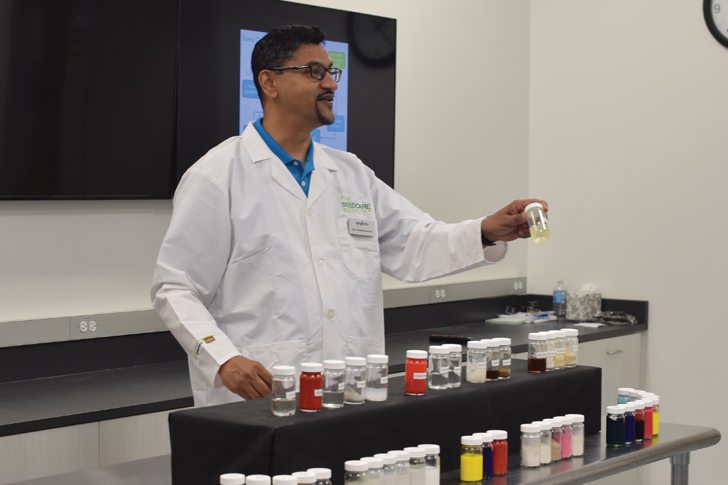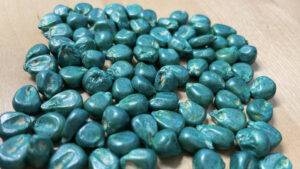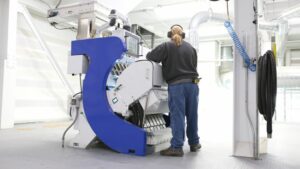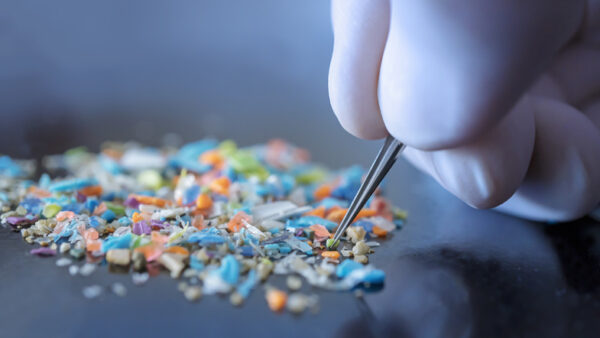Explore the science and innovations behind what’s applied to the seed and how it all comes together.
In the past decade, a great deal has changed when it comes to not only what we know about seed treatments, but how they are applied to the seed. Seen as a way to sustainably target pests and pathogens of concern during those first few weeks, chemists and formulation specialists have been hard at work finding new combinations and creating ways to add more active ingredients, including biologicals.
“Ten years ago, maybe one to three actives max were applied to the seed,” says Christophe Lupfer, who leads Seedcare application North America for Syngenta. “Today we have one product that contains up to seven active ingredients, and then we can add non-active products to the mix to help make sure the product stays on the seed and to get it just the right color for branding purposes, what we at Syngenta define as functional adjacent technologies.”
BASF’s Justin Clark, a technical marketing manager, agrees seed treatments are where the action is at.
“You are going to see some really innovative things that you haven’t seed from basic manufacturers, with biological products in what they can do in combination with chemical AIs,” Clark shares. “As we start to scratch the surface about what the different components on the seed can do for us, it’s important to take a holistic, on-seed approach, and look at the benefits you are gaining from each individual component, because there are some many things going on with seed these days.”
Ritesh Sheth agrees: “Everything is interactive.”

As chief chemist for Stoller USA, he explains that it’s not as simple as just adding one product to a mix. “Adding one ingredient could be detrimental to another ingredient,” he says, meaning balance and ratios are of utmost importance.
It’s easy to see the complexity of these formulations has only intensified during recent years and the addition of biologicals (bacteria, fungus, micronutrients, hormones and growth regulators) only complicates the job of chemists who specialize in this growing niche.
Syngenta’s Lupfer says that by adding biologicals to the mix, companies are able to remove some of the chemistry, which is a good thing, as long as performance can be kept at the highest level for growers. Because biologicals are living organisms, he says they have more of a season-long affect versus a few weeks for other technologies.
But again, you can’t just add a biological and remove a chemistry and call it done, Lupfer explains. As living organisms, different biologicals will vary in how they react to being added to the seed with different chemistries — sometimes for the better and sometimes for the worse.
One company that specializes in plant growth regulators, which can be applied to the seed, is Stoller USA.
Plant growth regulators are an essential component of a plant, says Sheth. Plant growth regulators help increase nutrient uptake and affect how a plant deals with stress. Sheth explains that when a plant is growing, it’s always facing different types of stress.
“To cope with that stress, it’s down regulating these hormones to survive,” he says. “What we’re doing is bringing those hormones back into balance for the most efficient uptake of nutrients to produce the desired crop.”
Coping with Challenges
One of the challenges that comes with applying biologicals as a seed treatment is keeping these organisms alive and working long enough for them to do their job when planted.
Vive Crop Protection, in collaboration with partners, has been working to develop a protection technology that helps keep them alive from when the seed is treated to when it goes into the ground. This helps farmers get the maximum benefit associated with those biological products, says Darren Anderson, president of Vive Crop Protection.
As an example, some of those seed treatments are based around nematode control, Anderson says, noting that it is a really important application.
“Nitrogen fixation is obviously a big deal, but there’s also a lot of seed treatments based on these biologicals or microbes that are really designed to control early-season diseases and certain insect pests,” he says.
Anderson agrees with Clark that the amount of innovation going into this space right now is really incredible.
However, he says the challenge is the delivery system — being able to keep these organisms alive long enough to do their job.
“We are really excited to be able to bring a technology that does that to the table,” Anderson says.
The Innovation Process

At Syngenta, formulation specialists start the innovation process by screening active ingredients. Lupfer says they look at a number of factors, including viscosity, stability, shelf life and a whole host of other criteria.
“We are always in search of ways to reduce the loading rate,” he says, noting that seed treatment equipment automation has played a significant role in helping the industry achieve lower and lower loading rates.
“Ensuring product stability is critical to ensuring a quality application,” Lupfer says. “We’ve gotten our dosing rates so low that if we applied a product that wasn’t stable, some seed might receive more of an active than other seed.
“Regardless of whether we pour a cup of coffee or a gallon bucket, the consistency of the product needs to be there.”
Bayer SeedGrowth also has a team of engineers to tackle the highly complex challenge of maximizing seed treatment quality. This involves enhancing seed treatment equipment, product formulations and application recipes.
“There are a number of key questions we seek to answer in our work,” says Heinz-Friedrich Schnier, who heads the Bayer SeedGrowth Center in Monheim, Germany. “How stable is a product formulation? How well does it adhere to the seed? And how good is the flowability of the treated seeds?”
He says quality is impacted by seed loading, homogenous seed-to-seed distribution, dust levels and flowability.
Stoller’s Sheth agrees: one of the most important factors in supplying consistency of product and treatment application is stability.
“If you don’t have a product that is going to last you multiple years, then what good is it?” he asks.
Sheth says customers are paying good money, and want to have a great return on investment.
As manufacturers, Sheth says the companies need to ensure that the product is stable from the time it is packaged to when the farmer plants the seed in the ground.
“You can’t have a product that works today and not tomorrow,” Sheth says. “At the end of the day, it all comes back to higher yields and maximizing the potential of the plant.
“But we have to understand what’s stopping that plant from growing. It’s the stress factors and the environmental factors. With the ever-changing environment, we need to provide the right tools to help the plant survive through those changes.”
Innovation Priorities
The No. 1 priority the Syngenta Seedcare team must keep top of mind is safety. One of the things that the company is honing in on is automation.
Automation allows for a safer work environment, as seed treatment operators don’t have to handle the the product itself, and clean out is simpler.
But not far behind safety is efficacy. It’s a close first, too, Lupfer says.
“When we remove something from the seed, it needs to not only be safer for the seed and the environment but also more efficacious,” he adds.
The team working at the Syngenta Seedcare Institute, based in Stanton, Minn., works on both broad spectrum solutions as well as those tailored for a specific need or customer.
“We are looking for solutions that are really safe and can be adopted across a number of crops, equipment and environmental conditions,” Lupfer says. “Yet, we also have customers and operators who want a product tailored to their needs and situation.”
Vibrance was one of the first products to focus on both soil- and root-borne diseases, according to Lupfer.
On the Horizon
Looking ahead, Lupfer says his team is focused on four primary components: ease of application, adjacent technologies, safety and stewardship of the operator, and digital tools.
“We really want to make things as easy as possible for applicators,” Lupfer says
Just how easy? Lupfer compares buying a margarita premix to someone who pours their own concoction. The do-it-yourselfer might serve up a perfect margarita on Saturday night but then the following Friday, you notice something’s not quite the same. A premix, he says, ensures consistency for both the applicator as well as the end customer.
“In the future, I don’t think the most innovative technology comibinations will comprise only chemistry or only biologicals,” Lupfer says. “Rather, it will be some combination of both.”
Adjacent technologies are also key to advancing the seed treatment sector. These include colorant technologies and things that make the product last longer and protect the seed pre-planting and post-planting.
Again, safety remains at the top of the priority list for Lupfer and his colleagues. This means safety at the time of treatment, when products are delivered, when seed is planted and during harvest.
Syngenta formulation specialists look at the different environmental conditions a seed treatment will be exposed to during production, storage and on the farm. They also consider how it will affect non-target organisms.
“We steward safety throughout every stage of production and throughout the value chain,” Lupfer says.
The other thing Lupfer has his eye on is digital tools and automation, which he believes will be the future of the industry.
He clarifies: “We’re not looking to remove humans; we’re looking to provide more information that can aid in the decision-making process.”
He says these could come in the form of apps that tell customers real time the quality of the seed that’s being treated. These apps could come in the form of calculation tools, process control tools, or an exchange of information from the seed treatment applicator to the grower.
The development of these tools, as he sees it, could help with record keeping, calibration and tracking.
“This is where we want to be at the forefront,” Lupfer says. “Of course, education will be an essential component behind the scenes to get all these pieces in place, but that’s where we think the future is.”













